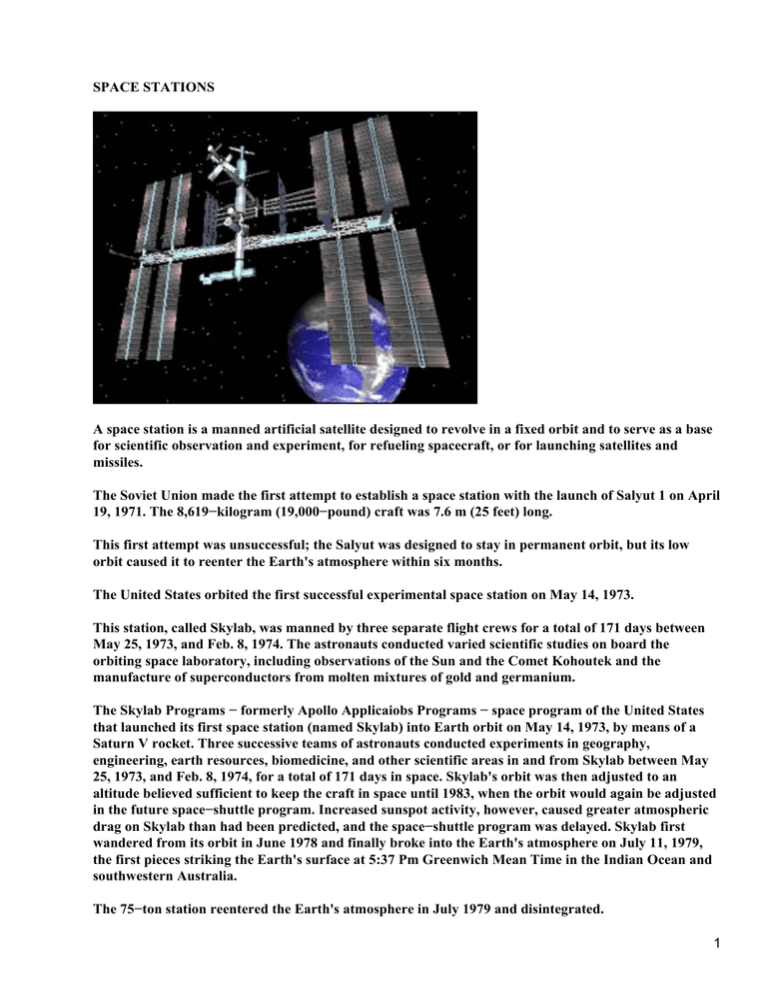Estaciones espaciales
Anuncio

SPACE STATIONS A space station is a manned artificial satellite designed to revolve in a fixed orbit and to serve as a base for scientific observation and experiment, for refueling spacecraft, or for launching satellites and missiles. The Soviet Union made the first attempt to establish a space station with the launch of Salyut 1 on April 19, 1971. The 8,619−kilogram (19,000−pound) craft was 7.6 m (25 feet) long. This first attempt was unsuccessful; the Salyut was designed to stay in permanent orbit, but its low orbit caused it to reenter the Earth's atmosphere within six months. The United States orbited the first successful experimental space station on May 14, 1973. This station, called Skylab, was manned by three separate flight crews for a total of 171 days between May 25, 1973, and Feb. 8, 1974. The astronauts conducted varied scientific studies on board the orbiting space laboratory, including observations of the Sun and the Comet Kohoutek and the manufacture of superconductors from molten mixtures of gold and germanium. The Skylab Programs − formerly Apollo Applicaiobs Programs − space program of the United States that launched its first space station (named Skylab) into Earth orbit on May 14, 1973, by means of a Saturn V rocket. Three successive teams of astronauts conducted experiments in geography, engineering, earth resources, biomedicine, and other scientific areas in and from Skylab between May 25, 1973, and Feb. 8, 1974, for a total of 171 days in space. Skylab's orbit was then adjusted to an altitude believed sufficient to keep the craft in space until 1983, when the orbit would again be adjusted in the future space−shuttle program. Increased sunspot activity, however, caused greater atmospheric drag on Skylab than had been predicted, and the space−shuttle program was delayed. Skylab first wandered from its orbit in June 1978 and finally broke into the Earth's atmosphere on July 11, 1979, the first pieces striking the Earth's surface at 5:37 Pm Greenwich Mean Time in the Indian Ocean and southwestern Australia. The 75−ton station reentered the Earth's atmosphere in July 1979 and disintegrated. 1 From 1974 to 1982 the Soviets succeeded in orbiting a series of smaller space stations−−Salyuts 3 through 7. Salyut 6 was occupied for a total of 676 days, and it reentered Earth atmosphere in 1982, three months after the launching of Salyut 7. Like their American counterparts, Soviet cosmonauts performed biomedical and other scientific work aboard the station for extended periods of time, the longest being a record−setting 237 days in 1984. On Feb. 20, 1986, the Soviets launched a new space station designed to serve as the core of a permanent manned orbiting facility. Known as Mir, the station had six docking ports for cargo transports, visiting manned spacecraft, and expansion modules, designed to be used as research laboratories and living quarters. MIR History of MIR MIR is a Soviet space station complex, the core module of which was launched in 1986. In subsequent years additional modules were lofted into space by separate rockets and attached to the docking ports of the core Mir unit, allowing the assembly of a permanently manned orbiting facility that could function as a large, flexible laboratory in space. Mir is the Russian word for "peace." Mir was the third generation of Soviet space stations. The satellites of the first generation, Salyuts 1 through 5 (launched 1971−76), had only one docking port, while those of the second generation, Salyuts 6 and 7 (1977, 1982), had two docking ports. Mir's core module resembles that of Salyut 7 but has six 2 docking ports, thus enabling a more complex station to be constructed in space. The Salyut series were any of a series of Soviet space stations that served as scientific laboratories and living quarters in Earth orbit for the crews aboard several Soyuz spacecraft. Soyuz craft and Progress cargo ferries routinely rendezvoused and docked with Salyut to transfer cosmonauts and supplies to the space station. The crews aboard Salyut were rotated periodically, enabling months−long habitations of the station. Salyut 1, launched April 19, 1971, was the world's first space station. Salyut 2 broke up shortly after launch. Salyuts 3 and 5 were military space stations, while Salyuts 4 and 6 were basically for civilian purposes. Salyut 6 (launched 1977) and Salyut 7 (launched 1982) were of a new and more advanced design that featured docking ports at both the aft and forward ends, a new refueling system, and better living quarters for the crew. The docking ports can accommodate cargo ferries, visiting manned spacecraft, or expansion modules equipped as specialized research facilities. Besides its six docking ports, Mir features expanded living quarters, greater available power, and modernized research equipment. The core module has a mass of 21 metric tons (23 tons), a length of 13.13 m (43 feet), and a width of 4.2 m (13.8 feet) at its maximum diameter. The core module is essentially a long cylinder, with a docking port at each end and four ports sited radially around a docking fixture at the forward end of the craft. The living area consists of two rooms end−to−end that are used for controlling the spacecraft, conducting research, dining, and recreation. There are also a bathroom and two small individual cabins. The station's electrical power is generated by two arrays of solar cell panels. The tail section of the core module has two large rocket engines that can make adjustments to the craft's orbit and 32 small thrusters that are used to control its attitude. The core module of Mir was launched on Feb. 20, 1986, and on March 13, 1986, cosmonauts Leonid Kizim and Vladimir Solovyev were sent aloft aboard a Soyuz spacecraft to rendezvous with Mir and become its first occupants; they spent 53 days adjusting equipment and bringing the complex into workable order. On May 6 the two cosmonauts left Mir in the Soyuz craft and transferred to the still−orbiting Salyut 7 station, thus completing the first human transfer from one space station to another. Other cosmonauts soon visited the Mir station, which was kept supplied by periodic visits of unmanned Progress cargo ferries. Some cosmonauts stayed on the Mir for missons lasting six months or even a year. A record set by a Mir crew member in 1987 for the longest time (326 days) spent in space was broken (366 days) by two other Mir cosmonauts in December 1988, but these feats were far surpassed by Mir crewman Valery Polyakov, who returned to Earth on March 22, 1995, after having spent 438 days in space. In March 1987 the Soviets launched the first large specialized module to the Mir complex. Known as Kvant ("Quantum") 1, this first module was basically an astrophysics observatory. It weighed more than 20 metric tons, almost as large as the basic Mir, and in itself almost doubled the habitable volume of the space station. The service module Kvant 2 (launched November 1989) contained equipment for producing oxygen and 3 recycling the station's water supplies, as well as a shower, a sink, and an airlock for spacewalks so that cosmonauts could perform outside maintenance work. The technology module Kristall ( "Crystal"; May 1990) contained furnaces and other equipment for processing materials in space. This module was also fitted with a docking port for linkups with the Soviets' Buran space shuttle, which was later abandoned. The Spektr ("Spectrum") science module (May 1995) contained remote−sensing instruments to study the gases of the Earth's atmosphere. Mir's assembly was completed when Priroda ("Nature"), a science module containing remote−sensing instruments with which to study the Earth's environmental health and ecology, was docked to the station in April 1996. The aging Mir station suffered a series of equipment failures and accidents in 1996−97 but remained in service. November 2000 − there are those who are struggling to save MIR. It is now abandoned. A new space station is being built. It is called the International Space Station. THE INTERNATIONAL SPACE STATION THE INTERNATIONAL SPACE STATION 4 International Space Station (ISS), with contributions from 16 nations, is the largest and most complex international scientific project ever undertaken. The major partners and their space agencies are the United States (NASA), Russia (RSA), European Space Agency (ESA), Japan (NASDA), and Canada (CSA). 5 It will take some 45 flights to send everything needed to space. NASA estimates that 36 American shuttle flights and nine Russian rocket launches will be needed over five years to build the station in orbit by about 2005. They will haul almost 900,000 pounds (405,000 kilograms) of prefabricated building material to a construction site in low Earth orbit. Flying 235 miles (378 kilometers) above Earth, astronauts will carry out 140 dangerous spacewalks to piece together station parts, racking up 1,700 working hours in space. On the ground, more than 100,000 workers in the United States, Russia, Japan, Canada, Brazil and 11 European nations will be finishing science labs the size of mobile homes, power plants to generate electricity Ð even sewage−treatment systems destined for the station. Simply said, the $60 billion project is considered by many to be the most difficult, dangerous and expensive international engineering endeavor of all time. When complete, ISS will have a mass of more than one million pounds (453,000 kilograms) and provide six state−of−the−art laboratories for international research. 6


